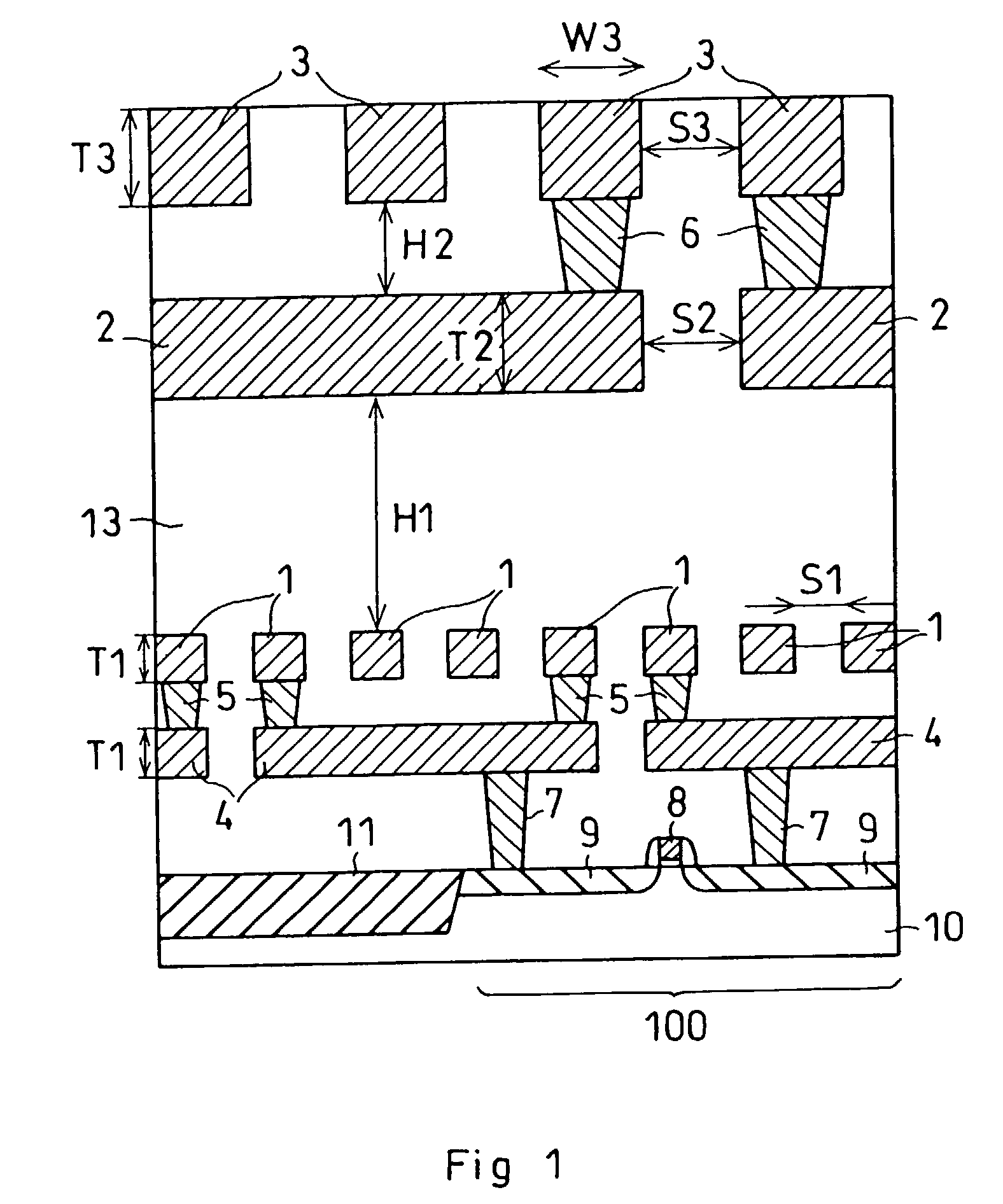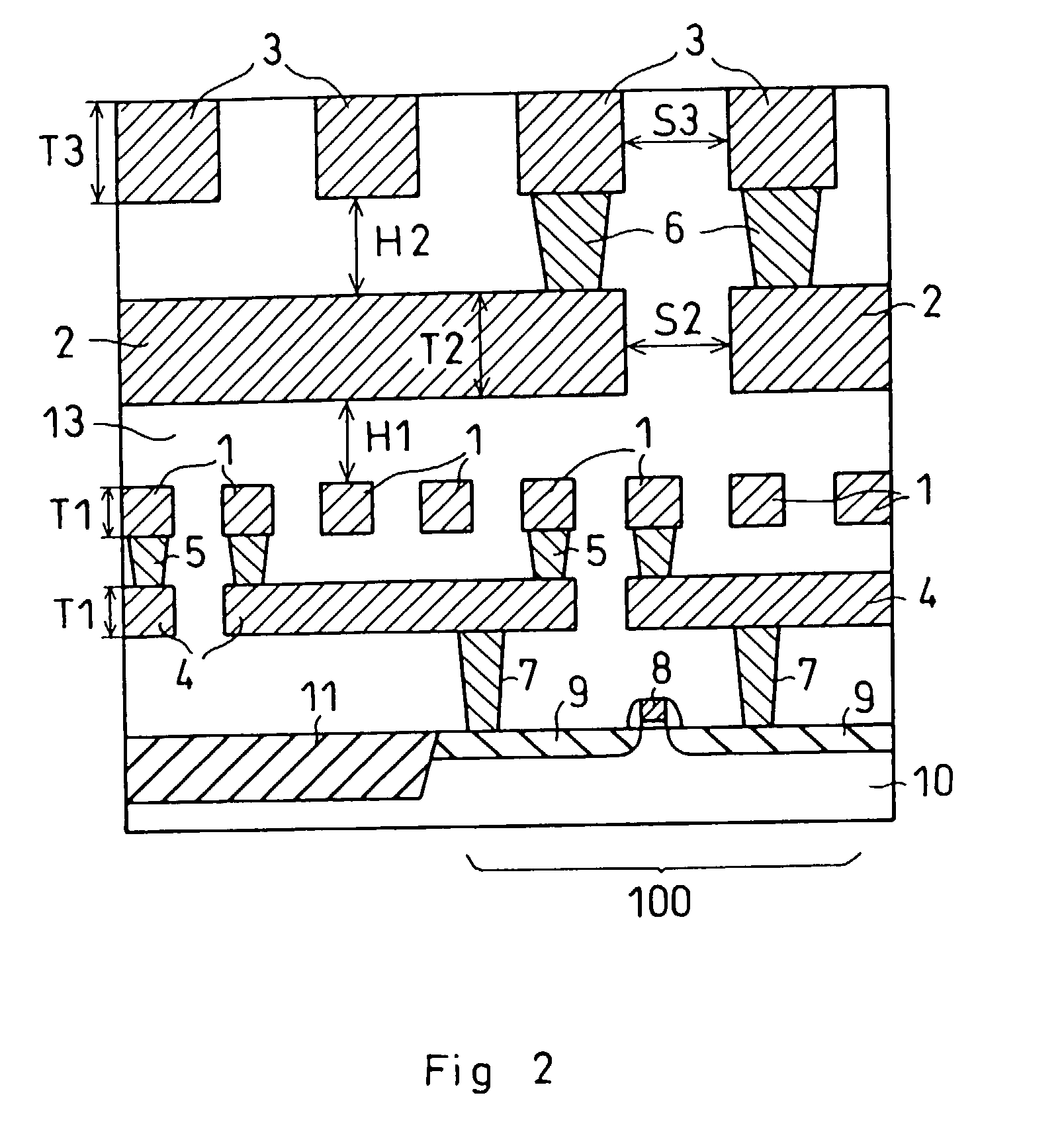Semiconductor device
a technology of semiconductor devices and logic circuits, applied in semiconductor devices, semiconductor/solid-state device details, electrical apparatus, etc., can solve the problems of increasing power consumption, unable to meet the requirements of high-integrated logic circuits, and no longer expectable device operation speed,
- Summary
- Abstract
- Description
- Claims
- Application Information
AI Technical Summary
Benefits of technology
Problems solved by technology
Method used
Image
Examples
first embodiment
[0078] FIG. 1 is a diagram illustrating, in cross-section, a semiconductor device in accordance with the present invention. In FIG. 4, an exploded perspective view of an internal structure of the device shown in FIG. 1, including planar layout patterns of respective wirings stacked or laminated over one another. In FIG. 4, for the purpose of visually emphasizing the wirings of interest, depiction of a semiconductor substrate region and contacts is eliminated, and dotted lines indicate the connection relationship between such contacts and interconnect wirings.
embodiment 1
[0079] In the embodiment 1, the wirings are divided into two groups: "local" wirings (wiring 4 and first wiring 1), and "global" wirings (second wiring 2 and third wiring 3) as formed over the local wirings. A distance between global wiring (the second wiring 2) and local wiring (the first wiring 1) is designed to be wider than a distance between the global wirings (the second wiring 2 and the third wiring 3). A wiring thickness of global wiring (the second wiring 2 and the third wiring 3) is greater than a wiring thickness of local wiring layer (the wiring 4 and the first wiring 1). An amplitude of a signal voltage of the global wirings (the second wiring 2 and the third wiring 3) is lower than an amplitude of a signal voltage of the local wirings (the wiring 4 and the first wiring 1).
[0080] In this invention, "an amplitude of a signal voltage" of wirings means the voltage difference between two voltages that correspond to two logical states at steady states, respectively. For exam...
embodiment 2
[0168] FIG. 15 is a diagram showing in cross-section a multilayer wiring structure of a semiconductor device in accordance with a second embodiment of the present invention, including a semiconductor substrate region thereof. The same parts or components as those in FIG. 1 are designated by the same reference characters, and an explanation thereof will be eliminated herein.
[0169] This embodiment shown is the one that a fourth wiring 12 is further formed over the third wiring 3 in the first embodiment stated supra, wherein a distance H1 between the first wiring 1 and the second wiring layer 2 is greater than a distance H2 between the third wiring 3 and the fourth wiring 12.
[0170] In FIG. 15, depiction of the part underlying the second wiring 2 is omitted, as it is the same in structure as that of the first embodiment set forth previously.
[0171] A insulating film 13 (a firth insulating film) is deposited on an entire upper surface of the second wiring 2 to have a thickness greater in ...
PUM
 Login to View More
Login to View More Abstract
Description
Claims
Application Information
 Login to View More
Login to View More - R&D
- Intellectual Property
- Life Sciences
- Materials
- Tech Scout
- Unparalleled Data Quality
- Higher Quality Content
- 60% Fewer Hallucinations
Browse by: Latest US Patents, China's latest patents, Technical Efficacy Thesaurus, Application Domain, Technology Topic, Popular Technical Reports.
© 2025 PatSnap. All rights reserved.Legal|Privacy policy|Modern Slavery Act Transparency Statement|Sitemap|About US| Contact US: help@patsnap.com



